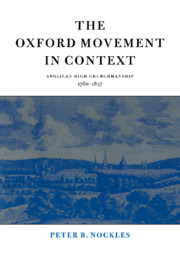Book contents
- Frontmatter
- Contents
- Preface
- List of abbreviations
- Historiographical introduction
- 1 Church and state: the politics of High Churchmanship
- 2 Antiquity and the rule of faith
- 3 Ecclesiology: the apostolic paradigm
- 4 Spirituality, liturgy and worship
- 5 The economy of salvation: sacraments and Justification
- 6 The old High Churchmen and Tractarians in historical relation
- Conclusion
- Select bibliography
- Index
4 - Spirituality, liturgy and worship
Published online by Cambridge University Press: 23 September 2009
- Frontmatter
- Contents
- Preface
- List of abbreviations
- Historiographical introduction
- 1 Church and state: the politics of High Churchmanship
- 2 Antiquity and the rule of faith
- 3 Ecclesiology: the apostolic paradigm
- 4 Spirituality, liturgy and worship
- 5 The economy of salvation: sacraments and Justification
- 6 The old High Churchmen and Tractarians in historical relation
- Conclusion
- Select bibliography
- Index
Summary
HIGH CHURCHMANSHIP AND ASCETICISM
The Oxford Movement was primarily a spiritual force, a quest for holiness through self-denial and mortification of bodily and worldly appetites. Included in the ‘ascetic motive’ were strict notions of prayer, alms-giving, fasting, the ideal of poverty, voluntary retirement, repentance and penance. Asceticism was practised by the Movement's leaders, notably Froude, Pusey and Newman in his Littlemore years. An abiding Tractarian fear was Tor people to be made high churchmen in a great hurry as high as steeples and be no better for it’. Yet there was continuity with at least an element of the High Church tradition. As a writer in the Evangelical Record conceded in 1838, contemporary High Churchmanship had ‘formed a compact with fasting, long prayers, observance of days, great show of devotion’, but these were ‘no strangers to it; they have been its supporters many times before’.
The ascetical strain in High Church spirituality had found appealing expression in seventeenth-century figures such as George Herbert, Nicholas Ferrar, Thomas Ken and Ambrose Bonwicke, and, in the eighteenth century, Robert Nelson, William Law and Bishop Wilson. When Pusey advocated fasting in Tract 18 and Tract 66, he drew on this testimony.
Law's spirituality influenced the young John Wesley and the Oxford Methodists in the early 1730s. In the middle years of the eighteenth century, it left its mark on the Hutchinsonians. Home's and Stevens's habits of fasting and regard for the ideal of celibacy owed much to Law's example.
- Type
- Chapter
- Information
- The Oxford Movement in ContextAnglican High Churchmanship, 1760–1857, pp. 184 - 227Publisher: Cambridge University PressPrint publication year: 1994



